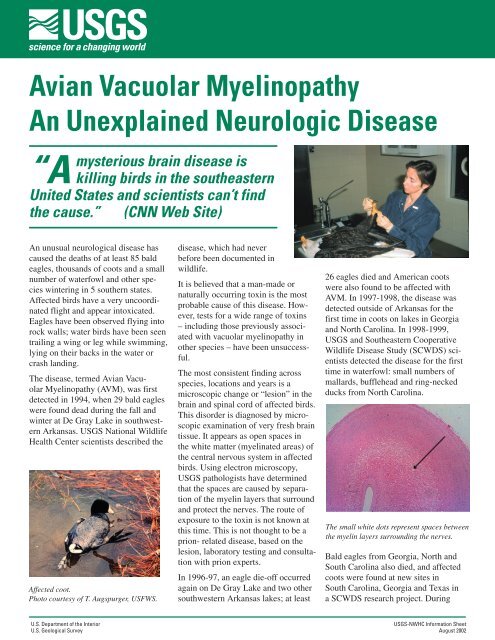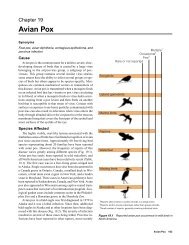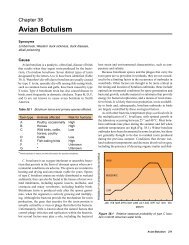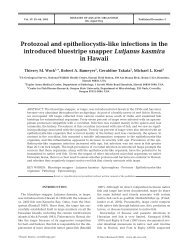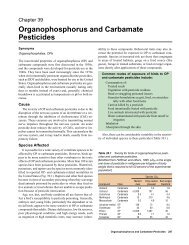Avian Vacuolar Myelinopathy An Unexplained Neurologic Disease
Avian Vacuolar Myelinopathy An Unexplained Neurologic Disease
Avian Vacuolar Myelinopathy An Unexplained Neurologic Disease
You also want an ePaper? Increase the reach of your titles
YUMPU automatically turns print PDFs into web optimized ePapers that Google loves.
<strong>Avian</strong> <strong>Vacuolar</strong> <strong>Myelinopathy</strong><br />
<strong>An</strong> <strong>Unexplained</strong> <strong>Neurologic</strong> <strong>Disease</strong><br />
“A<br />
mysterious brain disease is<br />
killing birds in the southeastern<br />
United States and scientists can’t find<br />
the cause.” (CNN Web Site)<br />
<strong>An</strong> unusual neurological disease has<br />
caused the deaths of at least 85 bald<br />
eagles, thousands of coots and a small<br />
number of waterfowl and other species<br />
wintering in 5 southern states.<br />
Affected birds have a very uncoordinated<br />
flight and appear intoxicated.<br />
Eagles have been observed flying into<br />
rock walls; water birds have been seen<br />
trailing a wing or leg while swimming,<br />
lying on their backs in the water or<br />
crash landing.<br />
The disease, termed <strong>Avian</strong> <strong>Vacuolar</strong><br />
<strong>Myelinopathy</strong> (AVM), was first<br />
detected in 1994, when 29 bald eagles<br />
were found dead during the fall and<br />
winter at De Gray Lake in southwestern<br />
Arkansas. USGS National Wildlife<br />
Health Center scientists described the<br />
Affected coot.<br />
Photo courtesy of T. Augspurger, USFWS.<br />
disease, which had never<br />
before been documented in<br />
wildlife.<br />
It is believed that a man-made or<br />
naturally occurring toxin is the most<br />
probable cause of this disease. However,<br />
tests for a wide range of toxins<br />
– including those previously associated<br />
with vacuolar myelinopathy in<br />
other species – have been unsuccessful.<br />
The most consistent finding across<br />
species, locations and years is a<br />
microscopic change or “lesion” in the<br />
brain and spinal cord of affected birds.<br />
This disorder is diagnosed by microscopic<br />
examination of very fresh brain<br />
tissue. It appears as open spaces in<br />
the white matter (myelinated areas) of<br />
the central nervous system in affected<br />
birds. Using electron microscopy,<br />
USGS pathologists have determined<br />
that the spaces are caused by separation<br />
of the myelin layers that surround<br />
and protect the nerves. The route of<br />
exposure to the toxin is not known at<br />
this time. This is not thought to be a<br />
prion- related disease, based on the<br />
lesion, laboratory testing and consultation<br />
with prion experts.<br />
In 1996-97, an eagle die-off occurred<br />
again on De Gray Lake and two other<br />
southwestern Arkansas lakes; at least<br />
26 eagles died and American coots<br />
were also found to be affected with<br />
AVM. In 1997-1998, the disease was<br />
detected outside of Arkansas for the<br />
first time in coots on lakes in Georgia<br />
and North Carolina. In 1998-1999,<br />
USGS and Southeastern Cooperative<br />
Wildlife <strong>Disease</strong> Study (SCWDS) scientists<br />
detected the disease for the first<br />
time in waterfowl: small numbers of<br />
mallards, bufflehead and ring-necked<br />
ducks from North Carolina.<br />
The small white dots represent spaces between<br />
the myelin layers surrounding the nerves.<br />
Bald eagles from Georgia, North and<br />
South Carolina also died, and affected<br />
coots were found at new sites in<br />
South Carolina, Georgia and Texas in<br />
a SCWDS research project. During<br />
U.S. Department of the Interior<br />
U.S. Geological Survey<br />
USGS-NWHC Information Sheet<br />
August 2002
the fall and winter of 2000-2001, the<br />
disease recurred in coots in North<br />
Carolina and coots and approximately<br />
16 bald eagles on a lake on the Georgia<br />
- South Carolina border. SCWDS<br />
investigators also confirmed AVM in<br />
several new species including Canada<br />
geese, great horned owls and killdeer.<br />
The USGS National Wildlife Health<br />
Center, in conjunction with multiple<br />
State and Federal agencies, is continuing<br />
collaborative field, laboratory<br />
and research efforts to determine the<br />
cause of the disease. Studies of wingclipped<br />
sentinel birds (mallards and<br />
coots) placed on a lake with recurrent<br />
AVM outbreaks have demonstrated<br />
that exposure to the causative agent<br />
of AVM is site-specific and seasonal<br />
(fall/winter). Feeding trials, using<br />
food materials collected from lakes<br />
with AVM outbreaks, are ongoing.<br />
This work may help to narrow the<br />
search for the causative agent.<br />
Wildlife biologists and managers are<br />
being encouraged to report observations<br />
of sick eagles, waterfowl and<br />
coots to the USGS National Wildlife<br />
Health Center.<br />
For additional information, please contact:<br />
Dr. Tonie E. Rocke<br />
U.S. Geological Survey<br />
National Wildlife Health Center<br />
6006 Schroeder Road, Madison WI 53711-6223<br />
(608) 270-2451 FAX (608) 270-2415<br />
http://www.nwhc.usgs.gov/<br />
Map of the southeastern United States showing mortality locations. The<br />
dots represent the year mortality was first documented at each location.<br />
Printed on recycled paper


